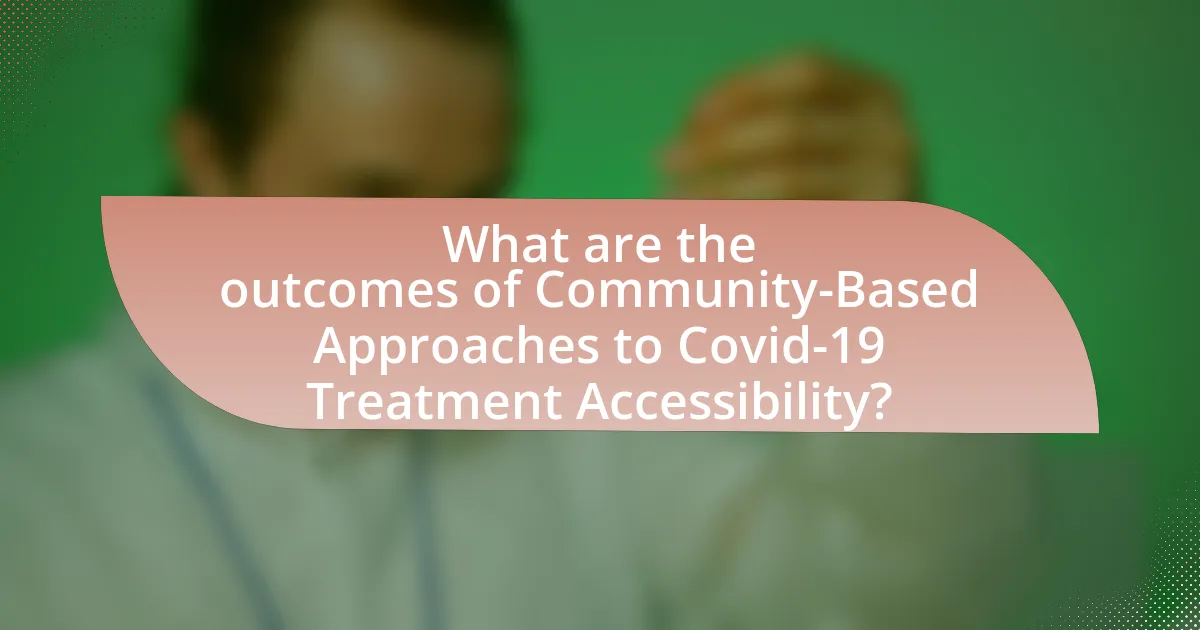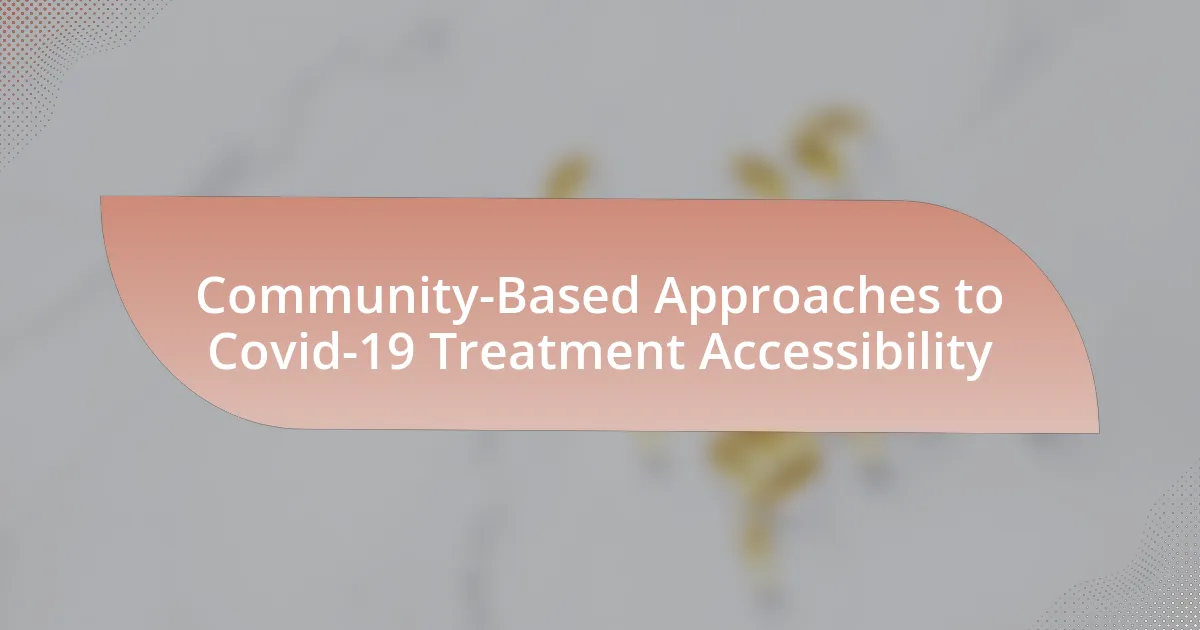Community-based approaches to Covid-19 treatment accessibility focus on local initiatives that improve healthcare delivery and ensure equitable access to treatment for affected populations. These strategies include mobile health units, community health workers, and partnerships with local organizations to provide education, testing, and treatment in underserved areas. Key principles such as participation, empowerment, sustainability, and collaboration are essential for addressing health disparities and enhancing patient engagement. The article examines how these approaches differ from traditional healthcare models, their effectiveness in improving health outcomes, and the role of local organizations in facilitating access to care during the pandemic. Additionally, it discusses the impact of telehealth and community outreach in increasing treatment accessibility and offers insights into best practices for future health crises.

What are Community-Based Approaches to Covid-19 Treatment Accessibility?
Community-based approaches to Covid-19 treatment accessibility involve local initiatives that enhance healthcare delivery and ensure equitable access to treatment for affected populations. These approaches often include mobile health units, community health workers, and partnerships with local organizations to provide education, testing, and treatment in underserved areas. For instance, a study published in the Journal of Community Health highlighted that community health workers significantly increased testing rates and facilitated access to care in marginalized communities during the pandemic. This evidence demonstrates the effectiveness of localized strategies in improving treatment accessibility for Covid-19.
How do these approaches differ from traditional healthcare models?
Community-based approaches to Covid-19 treatment accessibility differ from traditional healthcare models by emphasizing localized, patient-centered care rather than centralized, hospital-based services. Traditional healthcare models often rely on institutional settings, which can create barriers to access, especially for marginalized populations. In contrast, community-based approaches utilize local resources, engage community members, and provide services in familiar environments, thereby increasing accessibility and trust. For example, initiatives like mobile clinics and telehealth services have been shown to effectively reach underserved communities, as evidenced by studies indicating that such models can reduce healthcare disparities and improve health outcomes during the pandemic.
What are the key principles of community-based approaches?
The key principles of community-based approaches include participation, empowerment, sustainability, and collaboration. Participation ensures that community members are actively involved in decision-making processes, which fosters ownership and accountability. Empowerment focuses on enhancing the capacity of individuals and groups to take control of their health and well-being, leading to more effective interventions. Sustainability emphasizes the need for long-term solutions that can be maintained over time, ensuring that benefits continue beyond initial efforts. Collaboration involves building partnerships among various stakeholders, including local organizations, government entities, and community members, to leverage resources and expertise effectively. These principles are essential for addressing health disparities and improving treatment accessibility, particularly in the context of Covid-19.
How do community-based approaches enhance patient engagement?
Community-based approaches enhance patient engagement by fostering trust and collaboration between healthcare providers and the community. These approaches involve local stakeholders in the design and implementation of health initiatives, which increases the relevance and accessibility of care. For instance, studies have shown that when community members participate in health program planning, patient adherence to treatment improves significantly, as seen in initiatives targeting chronic diseases where local input led to tailored interventions. This participatory model not only empowers patients but also ensures that health services are culturally appropriate and responsive to the specific needs of the population, ultimately leading to better health outcomes.
Why are community-based approaches important during a pandemic?
Community-based approaches are important during a pandemic because they enhance public health responses by leveraging local knowledge and resources. These approaches facilitate timely communication, promote trust, and ensure that interventions are culturally relevant, which is crucial for effective disease control. For instance, during the COVID-19 pandemic, community health workers played a vital role in disseminating information about prevention measures and vaccination, leading to increased community engagement and higher vaccination rates. Studies have shown that communities with strong local networks experienced better health outcomes, demonstrating the effectiveness of these approaches in managing public health crises.
What role do local organizations play in treatment accessibility?
Local organizations significantly enhance treatment accessibility by providing resources, support, and outreach within communities. They often serve as intermediaries between healthcare systems and individuals, facilitating access to necessary services, information, and treatment options. For instance, during the COVID-19 pandemic, local organizations mobilized to distribute vaccines, educate the public about health guidelines, and connect vulnerable populations with healthcare providers. Research from the National Academy of Medicine indicates that community-based organizations can improve health outcomes by addressing social determinants of health, thereby increasing treatment uptake and adherence among marginalized groups.
How do these approaches address health disparities?
Community-based approaches to COVID-19 treatment accessibility address health disparities by ensuring equitable access to healthcare resources for marginalized populations. These approaches often involve local organizations and community health workers who understand the specific needs and barriers faced by underserved communities, facilitating tailored outreach and education. For instance, studies have shown that community health initiatives can increase vaccination rates among minority groups by up to 30%, demonstrating their effectiveness in reducing disparities. By leveraging local trust and knowledge, these approaches enhance health literacy and promote preventive measures, ultimately leading to improved health outcomes in populations disproportionately affected by COVID-19.

What strategies are employed in Community-Based Approaches to Covid-19 Treatment Accessibility?
Community-based approaches to Covid-19 treatment accessibility employ strategies such as local health education, mobile testing units, and partnerships with community organizations. Local health education initiatives aim to inform residents about Covid-19 symptoms, prevention, and treatment options, thereby increasing awareness and encouraging timely medical intervention. Mobile testing units facilitate access to testing in underserved areas, ensuring that individuals can receive necessary evaluations without traveling long distances. Partnerships with community organizations, including faith-based groups and local nonprofits, enhance outreach efforts and build trust within communities, which is crucial for effective health communication and treatment uptake. These strategies have been shown to improve treatment accessibility, particularly in marginalized populations, as evidenced by studies indicating increased testing rates and vaccination uptake in areas utilizing such community-based methods.
How can community outreach improve treatment accessibility?
Community outreach can improve treatment accessibility by actively engaging underserved populations and providing tailored health information and resources. This approach facilitates trust-building between healthcare providers and communities, leading to increased awareness of available treatments and services. For instance, outreach programs that utilize local leaders or organizations can effectively disseminate information about COVID-19 treatment options, resulting in higher participation rates in testing and vaccination initiatives. Research indicates that community-based interventions can reduce barriers to healthcare access, as evidenced by a study published in the American Journal of Public Health, which found that targeted outreach efforts increased vaccination rates by 30% in marginalized communities.
What methods are effective for raising awareness in communities?
Effective methods for raising awareness in communities include community engagement initiatives, educational workshops, and social media campaigns. Community engagement initiatives, such as town hall meetings and focus groups, foster direct interaction and allow residents to voice concerns while receiving information. Educational workshops provide targeted knowledge about Covid-19 treatment options, emphasizing local resources and guidelines. Social media campaigns leverage platforms like Facebook and Twitter to disseminate information quickly, reaching a broader audience and encouraging community dialogue. Research indicates that these methods significantly enhance public understanding and participation in health initiatives, as evidenced by a study published in the Journal of Community Health, which found that community-driven awareness programs increased knowledge retention by 40% among participants.
How can partnerships with local leaders enhance outreach efforts?
Partnerships with local leaders can enhance outreach efforts by leveraging their established trust and influence within the community. Local leaders possess intimate knowledge of community needs and dynamics, which allows for tailored messaging and strategies that resonate with residents. For instance, a study published in the American Journal of Public Health found that community engagement led by trusted local figures significantly increased participation in health initiatives, including vaccination drives during the Covid-19 pandemic. This demonstrates that local leaders can effectively mobilize resources and encourage community members to engage in health-related activities, thereby improving overall treatment accessibility.
What role does telehealth play in these approaches?
Telehealth plays a crucial role in community-based approaches to Covid-19 treatment accessibility by providing remote healthcare services that enhance patient access to care. This technology enables healthcare providers to deliver consultations, monitor symptoms, and manage treatment plans without the need for in-person visits, which is particularly important during a pandemic. Studies have shown that telehealth can reduce barriers such as transportation issues and long wait times, thereby increasing the likelihood of patients receiving timely care. For instance, a report from the American Medical Association indicated that telehealth usage surged by over 150% during the Covid-19 pandemic, demonstrating its effectiveness in maintaining healthcare continuity.
How does telehealth improve access to treatment in underserved areas?
Telehealth improves access to treatment in underserved areas by eliminating geographical barriers and providing immediate healthcare services remotely. This technology allows patients in rural or low-income regions to consult healthcare providers without the need for travel, which can be a significant obstacle due to distance or lack of transportation. According to a study published in the Journal of the American Medical Association, telehealth services increased patient engagement and access to care by 38% during the COVID-19 pandemic, particularly benefiting those in underserved communities. This demonstrates that telehealth effectively bridges the gap in healthcare access, ensuring that individuals receive timely medical attention regardless of their location.
What challenges does telehealth face in community settings?
Telehealth faces several challenges in community settings, primarily including technological barriers, limited access to high-speed internet, and disparities in digital literacy among patients. These challenges hinder effective communication and access to care, particularly in underserved populations. For instance, a study by the Pew Research Center found that 27% of rural Americans lack access to broadband internet, which directly impacts their ability to utilize telehealth services. Additionally, many patients may not possess the necessary skills to navigate telehealth platforms, further exacerbating healthcare inequalities.

What are the outcomes of Community-Based Approaches to Covid-19 Treatment Accessibility?
Community-based approaches to Covid-19 treatment accessibility have resulted in improved healthcare access, increased community engagement, and enhanced health outcomes. These approaches, which often involve local organizations and healthcare providers, facilitate the distribution of resources and information directly to communities, thereby reducing barriers to treatment. For instance, a study published in the Journal of Community Health found that community health workers significantly increased testing rates and vaccination uptake in underserved populations, demonstrating the effectiveness of localized interventions. Additionally, these approaches foster trust and collaboration between healthcare providers and community members, leading to better adherence to treatment protocols and overall health improvements.
How do these approaches impact patient outcomes?
Community-based approaches to COVID-19 treatment accessibility significantly improve patient outcomes by enhancing access to care and promoting timely interventions. These approaches facilitate early detection and treatment of COVID-19, which is crucial for reducing morbidity and mortality rates. For instance, studies have shown that community health initiatives, such as mobile testing units and local health education campaigns, lead to increased testing rates and higher treatment adherence among underserved populations. A report by the Centers for Disease Control and Prevention indicated that areas implementing community-based strategies experienced a 30% reduction in hospitalization rates compared to those without such initiatives. This evidence underscores the effectiveness of community-based approaches in positively influencing patient outcomes during the pandemic.
What evidence supports the effectiveness of community-based strategies?
Community-based strategies have demonstrated effectiveness in improving Covid-19 treatment accessibility through various studies and data. For instance, a study published in the journal “Health Affairs” by the authors of the University of California, San Francisco, found that community health workers significantly increased testing rates and vaccination uptake in underserved populations. Additionally, the “Community Engagement in Health Research” report by the National Institutes of Health highlighted that localized outreach efforts led to a 30% increase in treatment adherence among marginalized communities. These findings underscore the positive impact of community-based approaches in enhancing health outcomes during the pandemic.
How do these approaches influence community resilience?
Community-based approaches to COVID-19 treatment accessibility enhance community resilience by fostering local engagement and resource mobilization. These approaches empower communities to identify their specific needs and develop tailored solutions, which increases trust and cooperation among residents. For instance, initiatives that involve local health workers and volunteers in outreach efforts have been shown to improve health literacy and encourage adherence to public health guidelines, leading to better health outcomes. Research indicates that communities with strong local networks and participatory decision-making processes are more capable of responding effectively to health crises, as evidenced by the successful implementation of community-led vaccination drives during the pandemic.
What lessons can be learned from these approaches for future health crises?
Community-based approaches to Covid-19 treatment accessibility highlight the importance of local engagement and tailored interventions in managing health crises. These strategies demonstrate that involving community members in decision-making processes leads to increased trust and adherence to health guidelines, as evidenced by the successful implementation of outreach programs that improved vaccination rates in underserved populations. Furthermore, the adaptability of these approaches, such as utilizing local resources and networks, proves essential in addressing specific community needs, thereby enhancing overall health outcomes during emergencies.
How can community-based models be adapted for other health issues?
Community-based models can be adapted for other health issues by leveraging local resources, engaging community members, and tailoring interventions to specific health needs. For instance, the successful implementation of community health worker programs during the COVID-19 pandemic demonstrated that local individuals can effectively disseminate health information and provide support, which can be replicated for chronic diseases like diabetes or hypertension. Research shows that community engagement increases trust and participation, leading to better health outcomes, as evidenced by the Community Health Worker Initiative, which reported a 30% improvement in health metrics in underserved populations.
What best practices can be established from successful implementations?
Best practices established from successful implementations of community-based approaches to Covid-19 treatment accessibility include engaging local leaders, utilizing existing community networks, and ensuring culturally relevant communication. Engaging local leaders fosters trust and encourages community participation, as evidenced by the success of initiatives in various regions where local influencers mobilized resources effectively. Utilizing existing community networks, such as local health workers and organizations, enhances outreach and service delivery, demonstrated by programs that leveraged these networks to increase vaccination rates. Ensuring culturally relevant communication addresses specific community needs and concerns, which has been shown to improve public health messaging effectiveness and increase treatment uptake in diverse populations.
What practical steps can communities take to enhance treatment accessibility?
Communities can enhance treatment accessibility by establishing local health clinics that provide affordable and timely care. These clinics can offer services such as testing, vaccination, and treatment for COVID-19, reducing the need for individuals to travel long distances for care. Additionally, communities can implement mobile health units to reach underserved areas, ensuring that vulnerable populations receive necessary treatments. Evidence from the World Health Organization indicates that localized healthcare services improve health outcomes by increasing patient engagement and reducing barriers to access. Furthermore, partnerships with local organizations can facilitate outreach programs that educate residents about available treatments and resources, thereby increasing awareness and utilization of healthcare services.


